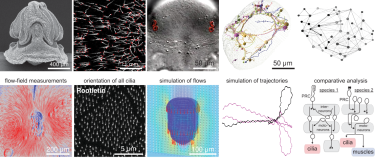
Funding
ERC Advanced Grant - PROTOEYE
From light detection to vision – revealing diversity of function of simple eyes and light-responsive behaviours to enlighten eye evolution
Complex animal eyes evolved many times independently from simpler forms. As already suggested by Darwin, the path to vision may have led from non-directional to directional light sensing and then to low-resolution spatial vision. Simple eyes in extant animals show a remarkable diversity of form and function and may hold the key to the origin of eyes and vision. We do not know why this diversity evolved when the organisms all respond to the same physical cue. Although we have a detailed molecular-centric view of eye evolution across animals, we lack corresponding knowledge of the physical mechanics and neuronal circuits coordinating the responses. PROTOEYE will study the diversity of simple non-visual and visual eyes and map the phase space of light-guided behaviours across animals. This will inform general principles of sensory system evolution and our understanding of the origin and evolution of eyes and visual circuits.
The project will build on our long-term expertise in neural circuits and mechanistic photo-biology. We will study a range of aquatic invertebrates with distinct behavioural strategies, unified by the presence of simple eyes and non-visual photoreceptors. Instead of looking at eyes in isolation, we will investigate light responses from a whole-organism perspective focusing on circuits, behaviour and the biophysics of motion. In order to obtain entire neuronal circuits driving photic behaviours, we will use whole-body serial electron microscopy and connectomics. With laser ablation, we will explore strategies of light-seeking or light-avoidance behaviours. In high-throughput behavioural assays we will test navigation strategies and sensitivities to different wavelengths. With high-speed imaging and flow tracing, we will investigate how animal movement is shaped by light. This comparative and multi-disciplinary project will chart the functional diversity of simple eyes and provide a new framework for understanding the evolution of animal vision.
Wellcome Trust Investigator Award
Modulation of circuit dynamics by noradrenergic signalling in the annelid model Platynereis
Noradrenalin promotes wakefulness and regulates heart rate and other functions. It was thought to only be been found in vertebrates, but we have discovered this molecule and its receptors in the marine annelid Platynereis dumerilii. In this project, we study noradrenergic signalling in Platynereis. Platynereis is a powerful new laboratory model for the study of the function of neural circuits. We use a multidisciplinary approach to understand the details of noradrenergic signalling at a single neuron resolution. Our work combines calcium imaging, transgenesis, CRISPR mutagenesis and behavioural assays. We also use volume electron microscopy to reconstruct the connectome of noradrenergic circuits.